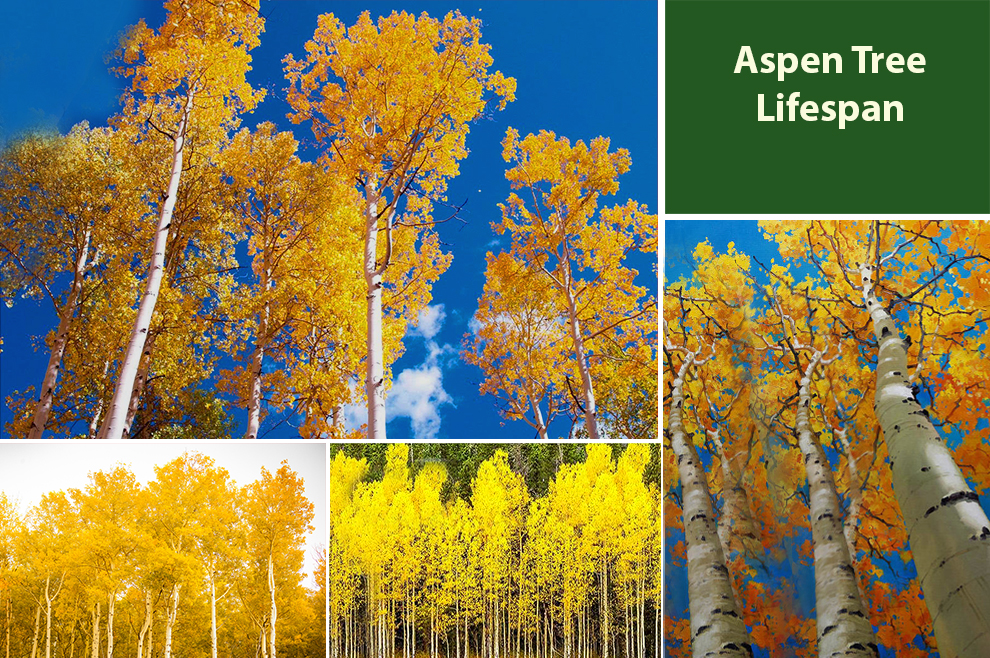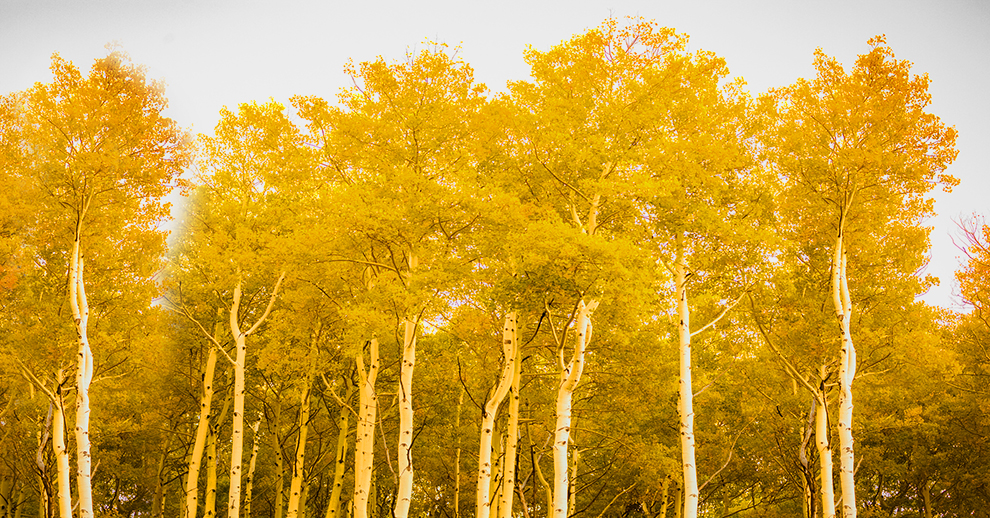How Long Do Aspen Trees Live (Lifespan)
Aspen trees can survive for twenty to seventy years in their non-native environment. However, in ideal conditions, they can even live up to a hundred-plus years.

Aspen trees are iconic deciduous trees commonly found in North America. Known for their distinctive leaves that flutter in the slightest breeze.
These trees exhibit clonal growth, meaning they reproduce through interconnected root systems, forming groves of genetically identical individuals.
While individual stems within a grove may have relatively short lifespans, the root system can persist for centuries, sending up new shoots that replace older stems.
As a result, determining the exact Aspen tree lifespan can be challenging. It can be anywhere between 20-70 years and sometimes up to 150 years due to the continuously growing roots.
The collective longevity of Aspen groves highlights their remarkable ability to adapt and persist across changing environments and serves as a testament to the intricacies of nature’s interconnected systems.
In this article, we shall learn more about the longevity and lifespan of Aspen trees, the factors that can hinder their growth, and some tips to increase their overall lifespan.
How Long Do Aspen Trees Live?
The general lifespan of individual Aspen trees can vary widely based on factors such as growing conditions, environmental stressors, disease, and human intervention.
On average, individual Aspen trees can live anywhere from 20 to 70 years. However, due to their clonal growth habit, where new shoots continuously sprout from the same interconnected root system, Aspen groves can potentially live for much longer, even up to 150 years.
Aspen groves, also known as “clonal colonies,” can persist for several centuries or even longer. Some well-known Aspen groves, such as the “Pando” grove in Utah, are estimated to be thousands of years old.
The individual stems within these groves may die and regenerate relatively frequently, but the interconnected root system allows the grove to continue its existence.
It’s important to note that the concept of “lifespan” can be a bit different for Aspen trees due to their clonal growth, and the focus is often on the overall longevity of the grove rather than the individual trees.
Do Different Aspen Trees Have Different Lifespans or The Same?
Different species of Aspen trees, such as quaking, bigtooth, European, Chinese, and Japanese Aspens, can exhibit variations in their lifespans.
While the general range of individual Aspen age is about 20 to 70 years, specific species and environmental conditions can lead to differences.
For instance, quaking Aspen is known for its relatively short-lived individual stems, while bigtooth Aspen can often live longer.
European, Chinese, and Japanese Aspen species may have varying lifespans depending on their habitat and local factors.
Factors such as climate, soil quality, and available resources influence the longevity of these trees within their respective regions.
What Affects Aspen’s Lifespan?

The lifespan of an Aspen tree is influenced by several factors. Genetics play a role; some trees are naturally predisposed to live longer due to their inherent characteristics.
Growing conditions, including soil quality, water availability, and climate, significantly impact the life of an Aspen. Healthy trees in optimal conditions tend to live longer.
Environmental stressors like drought, disease, pests, and competition for resources can shorten lifespans. Human activities such as deforestation, construction, and improper pruning can also negatively affect Aspen tree longevity.
By understanding these factors and providing appropriate care, it’s possible to help extend the lifespan of Aspen trees.
Regular maintenance, proper watering, pest and disease management, and protection against mechanical damage are essential to promoting the health and longevity of these iconic trees.
The lifespan of an Aspen tree is influenced by a complex interplay of environmental and other factors that can impact its health and vitality:
Environmental Factors:
Climate and Temperature: Aspen trees thrive in temperate climates with distinct seasons. Harsh conditions, such as extreme cold or prolonged drought, can stress trees and shorten their lifespan.
Soil Conditions and Nutrients: Well-draining soils with sufficient nutrients are crucial for Aspen growth. Poor soil quality can limit growth and contribute to a shorter lifespan.
Water Availability: Adequate water is essential, especially during the establishment phase. Drought stress can weaken trees and make them susceptible to pests and diseases.
Other Factors Affecting Aspen Lifespan:
Diseases and Pests: Aspen trees can be affected by various diseases and pests, such as cankers, leaf spots, aphids, and borers. Severe infestations or infections can lead to decline and premature death.
Competition with Other Plants: Aspens are often part of mixed forests. Intense competition for resources, like light, water, and nutrients, can negatively impact their growth and lifespan.
Human Impact: Activities such as improper pruning, construction, and deforestation can damage trees and reduce their lifespan. Protecting the trees from mechanical damage is crucial.
Climate Change: Changing climatic conditions, including altered precipitation patterns and increased temperatures, can stress Aspen trees and lead to increased vulnerability to pests and diseases.
A combination of these factors can synergistically influence an Aspen tree’s lifespan.
Providing optimal growing conditions, including well-draining soil, proper watering, and regular fertilization, can promote longevity.
As climate change becomes more pronounced, it’s important to adapt care practices to ensure Aspen trees can cope with changing environmental conditions and continue to thrive.
How Can You Extend The Aspen Trees’ Lifespan?
Extending the lifespan of an Aspen tree involves providing the right care and addressing potential threats to its health. Here are some tips to help you extend the lifespan of an Aspen tree:
- Choose a sunny, well-drained planting site.
- Water deeply but infrequently, especially during establishment.
- Mulch with organic material to conserve moisture and regulate temperature.
- Prune dead or crossing branches for a strong structure.
- Monitor and manage pests and diseases promptly.
- Apply a balanced slow-release fertilizer in spring.
- Protect against mechanical damage and soil compaction.
- Allow some natural shoots for clonal growth.
- Regularly inspect for stress and consult an arborist if needed. These practices will promote the health and longevity of your Aspen tree.
Aspens have a clonal growth habit, and their interconnected root systems can produce new shoots. Learn to grow Aspen trees and allow some shoots to grow naturally, as this is part of the tree’s ecological role.
Remember that the lifespan of trees can be influenced by various factors, including the local climate, soil conditions, and tree species. Providing consistent care and addressing issues promptly will help ensure the health and longevity of your Aspen tree.
If you encounter significant challenges or issues, consider seeking advice from a certified arborist or horticulturist for personalized guidance.
What Is The Oldest Living Aspen Tree?
There are some Aspen groves, also known as “clonal colonies,” that are considered to be among the oldest living organisms on Earth.
One well-known example is the “Pando” grove in Utah, USA. Pando is estimated to be thousands of years old and covers about 106 acres. The individual stems in Pando are genetically identical and share a common root system.
